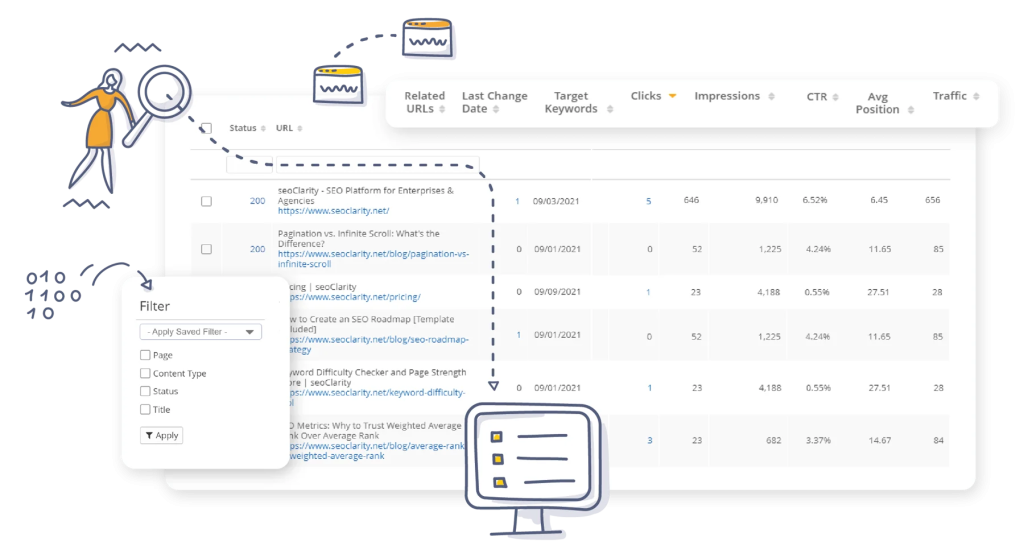What Is an SEO Monitoring Tool?
Google Search Console is a free platform created by Google to help website owners, SEO professionals, and small business owners monitor, maintain, and optimize their site’s performance in Google Search. Pricing:
What to Look for in an SEO Monitoring Tool for Your Website:
- SEO functionality
- Extensive reporting tools
- Ease of use
- Integrations
- Value for money
A. SEO Functionality
Whether you’re writing something new or updating old posts, Surfer makes on-page SEO easier to manage and measure. You’ll get helpful features like content scores, keyword ideas, and audits, all in a simple, easy-to-use dashboard.Cons:What makes it really stand out is how it uses machine learning to highlight the most important takeaways, so you can focus on what actually moves the needle.
B. Extensive Reporting Tools
Pricing:Paid plans start at €99.00/ month.
C. Ease of Use
Cons:Pros:
D. Integrations
Free
E. Value for Money
Paid plans start at 9.95/month.Pros:
Best SEO Tools to Monitor Your Website’s Performance:
- XOVI
- SurferSEO
- SemRush
- Google Search Console
- Ahrefs
- Buzzsumo
- SEOptimer
- SERanking
- seoClarity
- seoQuake
1. XOVI
Paid plans start at 9/ month.Features:Pros:Ahrefs is known for its strong backlink analysis, keyword research, and content optimization features. Although it focuses only on Google data, Ahrefs gives you everything you need to track rankings, audit websites, and reverse-engineer competitor strategies.  Pros:
Pros:
- Keyword research & monitoring: Discover high-performing keywords and track how your site ranks for them over time.
- On-page SEO audits: Get detailed recommendations for improving your site structure, content, and technical performance.
- Competitor analysis: See how your site stacks up against the competition and uncover gaps or opportunities in your niche.
- Custom reports & dashboards: Create white-label reports and automate delivery to clients or team members.
- Local search engine optimization tools: You can optimize for specific regions or cities, making it ideal for businesses targeting local customers.
- Content optimization: Analyze and improve your landing page content based on keyword targeting and readability.
- Backlink monitoring: Track your backlink profile and identify which links are helping (or hurting) your rankings.
- SERP snippet previews: Preview how your titles and descriptions appear in search results across different devices.
- AI content writer: Use the built-in AI assistant to help with SEO-optimized content writing directly within the platform.
Pros:
- Content editor: Get real-time feedback on word count, structure, and keywords while you write, based on what’s working for top-ranking pages.
- Keyword research: Discover content ideas, assess keyword difficulty, and explore search intent and volume.
- SERP analyzer: Deep-dive into your competitors’ content to understand what makes them rank, and how you can improve.
- Content audit: Analyze existing content and get suggestions to improve rankings by fixing keyword usage, structure, and missing backlinks.
- Grow Flow: An AI-powered assistant that gives weekly SEO suggestions to help you steadily improve your site’s performance.
- Keyword Surfer (Chrome extension): See search volume, CPC, and content word count right from your Google search results.
- AI outline generator: Quickly build article outlines and headings based on solid data from SERP.
- AI writer: Generate ready-to-publish blog posts with Surfer’s AI content generator (add-on).
- Google Docs & WordPress integration: Optimize content where you work, with real-time SEO suggestions directly in your editor.
- SEMrush integration: Bring in backlink and keyword data from SEMrush for deeper analysis.
Pros:
- Domain overview & traffic analytics: Understand any site’s organic and paid traffic, traffic sources, and audience insights.
- Keyword Magic Tool: Discover high-potential keywords with filters for intent, difficulty, and volume.
- Backlink analytics: Analyze your backlink profile and that of competitors, with metrics like anchor texts and referring domains.
- Site audit: Identify and fix technical SEO issues to improve site health and ranking.
- Position tracking: Monitor keyword rankings daily and spot visibility changes or keyword cannibalization.
- Content marketing toolkit: Create SEO-optimized content, generate ideas, and analyze top-performing articles.
- Advertising research: Track competitors’ PPC ads, keywords, and estimated spending.
- Market explorer: Get insights into your niche, audience interests, and fast-growing competitors.
- SEO content template: Get content guidelines based on what top-ranking competitors are doing.
- Link building tool: Find outreach prospects and manage campaigns directly in the platform.
Pros:
- Performance reports: View clicks, impressions, CTR, and average position for keywords and pages.
- URL inspection tool: Diagnose and troubleshoot how individual URLs are indexed.
- Index Coverage Report: See which pages are indexed, excluded, or causing errors.
- Sitemaps Submission: Submit and monitor XML sitemaps to help Google crawl your site more efficiently.
- Core Web Vitals Reporting: Assess real-world performance metrics like LCP, FID, and CLS.
- Manual Actions & Security Issues: Get alerts about penalties, hacked content, or malware.
- Enhancements Reports: Analyze structured data, breadcrumbs, and product listings.
- Integration: Easily connects with Google Analytics and Looker Studio.
- Free API Access: Retrieve data for automation or integration into your SEO dashboards.
Pros:
- Site explorer: View backlink profiles, referring domains, anchor texts, and organic/paid traffic stats for any domain.
- Keywords explorer: Get in-depth data like keyword difficulty, search volume, clicks-per-search, CPC, and traffic potential.
- Rank tracker: Monitor keyword positions over time with desktop/mobile breakdowns and SERP feature ownership.
- Site audit: Analyze site health, Core Web Vitals, indexing issues, and performance data pulled from PageSpeed Insights.
- Content explorer: Discover high-performing content on specific topics, check traffic, backlinks, and social shares.
- Backlink tools: Track broken backlinks, see referring IPs/domains, and use advanced filters to qualify link opportunities.
- Keyword gap analysis: Compare up to 10 competitors to find missing or untapped keywords.
- AI content helper: Optimize content for intent and keyword usage with AI-suggested titles, meta descriptions, and outlines.
- Alerts & monitoring: Set up email notifications for new backlinks or keyword ranking changes.
- Integrations: Connect with Google Search Console and Looker Studio for enhanced reporting.
Pros:
- Content discovery tools: Find the most shared and engaging content across the web for any topic or keyword, with filters by language, country, date, and more.
- Trending topics dashboard: Track what’s gaining traction in search engine results right now across various industries or custom topics using real-time trend monitoring.
- Influencer discovery: Identify top influencers on Twitter, YouTube, Facebook, and TikTok based on relevance, engagement, and audience size.
- Backlink and sharer insights: See who linked to or shared a piece of content—ideal for competitor research and outreach strategies.
- Content Analyzer: Analyze articles by engagement type (likes, shares, comments), content length, publish date, and format to find what works best.
- Content brief generator: Automatically create article outlines with keyword suggestions, user questions, and competitive content examples.
- Alerts and monitoring: Set up real-time alerts for keywords, brand mentions, new backlinks, or content from specific authors or domains.
- Projects and saved lists: Organize and manage all your research, influencer lists, and content findings in dedicated workspaces for each project.
Pros:
- SEO audit tool: Scan over 100 technical, on-page, and performance factors in seconds, with actionable recommendations.
- White-label PDF reports: Customize reports with logos, brand colors, and multilingual support—great for client delivery.
- Embeddable audit tool: Capture leads by embedding an SEO checker on your site, complete with branding and lead notification integrations.
- Keyword tracking: Monitor keyword rankings by location, search engine, and device, with weekly performance updates.
- Keyword research: Analyze keyword volume, competition, and CPC—plus suggestions for adjacent keywords and SERP previews.
- Backlink research & monitoring: Explore backlink profiles, monitor new/lost links, and receive alerts for changes or threats.
- SEO crawler: Crawl your site using a JavaScript-rendering engine that catches issues across dynamic platforms like Shopify and WordPress.
- Bulk reporting: Generate hundreds or thousands of audits simultaneously and export consolidated insights for large-scale campaigns.
- API access: Automate audits and integrate them with CRMs or internal systems using JSON-based API requests.
- Free SEO toolbox: Access free tools like XML sitemap, meta tag, and robots.txt generators, plus validators for Core Web Vitals and SSL.
Pros:
- Rank tracking (by country, city & device): Monitor keyword performance across multiple regions and devices with ease.
- Backlink monitoring & auditing: Check total backlinks, domain authority, anchor text, link toxicity, and more.
- Website audit tool: Crawl your site to identify technical issues like slow pages, Core Web Vitals problems, and indexability errors.
- On-page SEO checker: Analyze individual pages for optimization opportunities, including headings, content, and metadata.
- Competitor research: Track rivals’ organic keywords, SERP visibility, and share of voice.
- Content marketing tools: Generate briefs, optimize articles, and identify semantic keywords using the Content Editor.
- Keyword research suite: View search volume, keyword difficulty, SERP competitors, and related terms.
- Local SEO tracking: Analyze Google Business Profile visibility, reviews, and ranking in map packs.
- Export to Google Sheets: Export research and ranking data directly for easier collaboration and analysis.
- White-label reports & API (Pro/Business plans): Customize and automate reporting with branded PDFs and integrated workflows.
Pros:
- AI-powered keyword research: Explore 32B+ keywords across 170+ countries, including intent signals, SERP features, and emerging trends.
- Daily rank tracking: Get pixel-level rank data for desktop and mobile, with support for local and international search engines.
- Competitor insights: Uncover competitors’ keyword performance, SERP visibility, and content strategies.
- AI-driven content briefs: Auto-generate SEO content briefs with target keywords, structure, and intent data for writers.
- Technical site audits: Perform over 100 checks, analyze crawl data, internal links, Core Web Vitals, and more.
- Internal linking automation: Use AI to optimize internal links across large websites without developer involvement.
- Log file analyzer: Track search engine bot behavior and discover crawl efficiency and indexing issues.
- SEO split testing: Run A/B tests on on-page changes and schema to measure impact on rankings.
- Scalable reporting: Build custom dashboards, automate reports, and integrate with GA, GSC, Adobe Analytics, and more.
- Video & YouTube tracking: Monitor rankings and competitor strategies across video SERPs and YouTube search.
Pros:
- On-page SEO audits: Instantly analyze any webpage for technical and content-related SEO metrics like titles, meta descriptions, alt tags, and headings.
- Keyword density analysis: Review keyword frequency, prominence, and placement across page titles, headers, and body content.
- Backlink checker: View a basic breakdown of internal and external links on any webpage, with indicators for follow/nofollow status.
- SERP overlay: Display real-time metrics—like domain authority, backlinks, and social shares—directly within Google search results.
- Social metrics tracker: Get a quick look at a page’s popularity across platforms like Facebook and Pinterest.
- SEO diagnosis tool: Run a fast technical audit that flags missing elements or errors on the page (like missing alt tags or meta info).
- Customizable parameters: Choose what SEO metrics you want to see and tailor the dashboard to match your workflow.
- Browser compatibility: Use across Chrome, Firefox, and Opera with seamless integration and quick access from your toolbar.
Whether you’re a beginner or just want to save time, the tool should feel easy from day one.
- Super easy to use, even for SEO beginners
- Puts helpful data directly into your search results
- Completely free with no account required for core features
Paid plans start at /month.
- Limited depth, as some data redirects to SEMrush for full insights
- Can slow down your browser when analyzing complex pages
- Data accuracy isn’t always consistent, making it more of a quick-check tool
- Lacks integrations and team collaboration features
Cons:Features:




